

Sell Everything — What I Learned Today. It was a dream opportunity.

In March 2013, my co-founder and I agreed to join MetaLab. I would be joining as Director of Labs to head up a new product division. Unfortunately, MetaLab’s office is located in Victoria, British Columbia — a full 2,300 miles away from where I was living in downtown St. Louis. :mnmlist. An attempt by Kelly Sutton to get rid of everything - Cult of Less. The Clutter Culture - Feature - UCLA Magazine Online. By Jack Feuer Published Jul 1, 2012 8:00 AM "For more than 40,000 years," write the authors, "intellectually modern humans have peopled the planet, but never before has any society accumulated so many personal possessions.
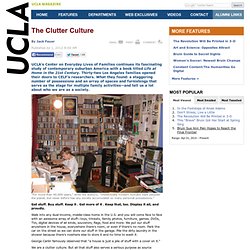
" Get stuff. Buy stuff. Trouble in paradise: UCLA book enumerates challenges faced by middle-class L.A. families. It's the place to look for the plumber's phone number, the date of the next doctor's appointment, that photo from your summer vacation and the spelling test your kid aced last week.
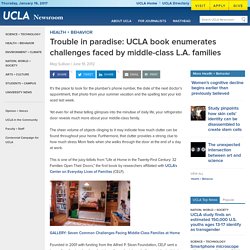
Yet even for all these telling glimpses into the minutiae of daily life, your refrigerator door reveals much more about your middle-class family. BBC Future column: Why we love to hoard. Here’s last week’s column from BBC Future. The original is here. It’s not really about hoarding, its about the endowment effect and a really lovely piece of work that helped found the field of behavioural economics (and win Daniel Kahneman a Nobel prize). On the 12th day of Christmas ... your gift will just be junk. Illustration by Daniel Pudles There's nothing they need, nothing they don't own already, nothing they even want.

Adbusters’ War Against Too Much of Everything. Thought Experiment: The 10-Piece Wardrobe. As part of my new ‘quality instead of quantity’ philosophy I’m trying to form a very clear idea about my personal style to make sure that when I invest in pieces I won’t be over them in a year or so.

Kazagistar comments on The High Price of Materialism. Living With Less. A Lot Less. I have come a long way from the life I had in the late ’90s, when, flush with cash from an Internet start-up sale, I had a giant house crammed with stuff — electronics and cars and appliances and gadgets.
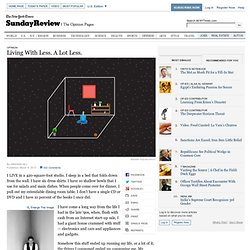
Somehow this stuff ended up running my life, or a lot of it; the things I consumed ended up consuming me. My circumstances are unusual (not everyone gets an Internet windfall before turning 30), but my relationship with material things isn’t. We live in a world of surfeit stuff, of big-box stores and 24-hour online shopping opportunities.
Members of every socioeconomic bracket can and do deluge themselves with products. There isn’t any indication that any of these things makes anyone any happier; in fact it seems the reverse may be true. Pick One. Abundance is a curse.

You can have anything that you want for lunch. So why eat another bland fast food hamburger and fries? There are literally hundreds of shows on the television. So why stare at another hour of screaming reality TV stars? You don’t eat, drink, or watch bad things because they are cheap. Global Capitalism with a Human Face? « AC VOICE. Eulogy of stuff. Shearing Layers of Stuff. Part of a series: Dematerialization One of my favourite concepts for thinking about architecture is the idea of shearing layers.
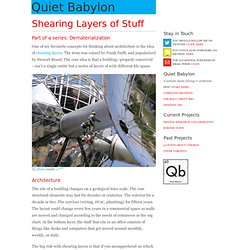
The term was coined by Frank Duffy and popularized by Stewart Brand. The core idea is that a building—properly conceived—isn’t a single entity but a series of layers of with different life spans. photo credit: e³°°° Architecture The site of a building changes on a geological time scale. The big risk with shearing layers is that if you misapprehend on which layer a component belongs, you end up with a building that’s extremely difficult to use. And things never really satisfy... Veronica in Archie comic.
Robocop Consume Obey Puff Zombies Movies Illustration. iDont Need Any of This Shit w logos. Calvin and Hobbes on Stuff January 31, 1993 on GoComics. The Salvation Army and Goodwill: Inside the places your clothes go when you donate them. Spencer Platt/Getty.
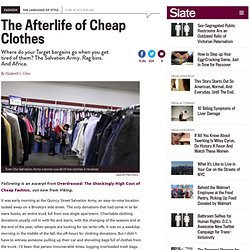
It was early morning at the Quincy Street Salvation Army, an easy-to-miss location tucked away on a Brooklyn side street. The only donations that had come in so far were books, an entire truck full from one single apartment. Charitable clothing donations usually roll in with fits and starts, with the changing of the seasons and at the end of the year, when people are looking for tax write-offs. It was on a weekday morning in the middle of the fall, the off-hours for clothing donations. But I didn’t have to witness someone pulling up their car and shoveling bags full of clothes from the trunk. Michael Noneza, otherwise known as “Maui,” one of the donation center’s assistant supervisors, bounced into the warehouse. The Quincy Street Salvation Army may be on a quiet out-of-the-way street, but it is the main distribution center serving eight Salvation Army locations in Brooklyn and Queens. Pius Utomi Ekpei/AFP/Getty Images.
Rag Drag by Nicole Gelinas. Overdressed: The Shockingly High Cost of Cheap Fashion, by Elizabeth L.
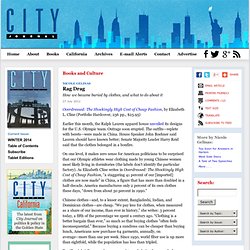
Cline (Portfolio Hardcover, 256 pp., $25.95) Earlier this month, the Ralph Lauren apparel house unveiled its designs for the U.S. Olympic team. Outrage soon erupted. The outfits—replete with berets—were made in China. On one level, it makes zero sense for American politicians to be surprised that our Olympic athletes wear clothing made by young Chinese women most likely living in dormitories (the labels don’t identify the particular factory). Chinese clothes—and, to a lesser extent, Bangladeshi, Indian, and Dominican clothes—are cheap.